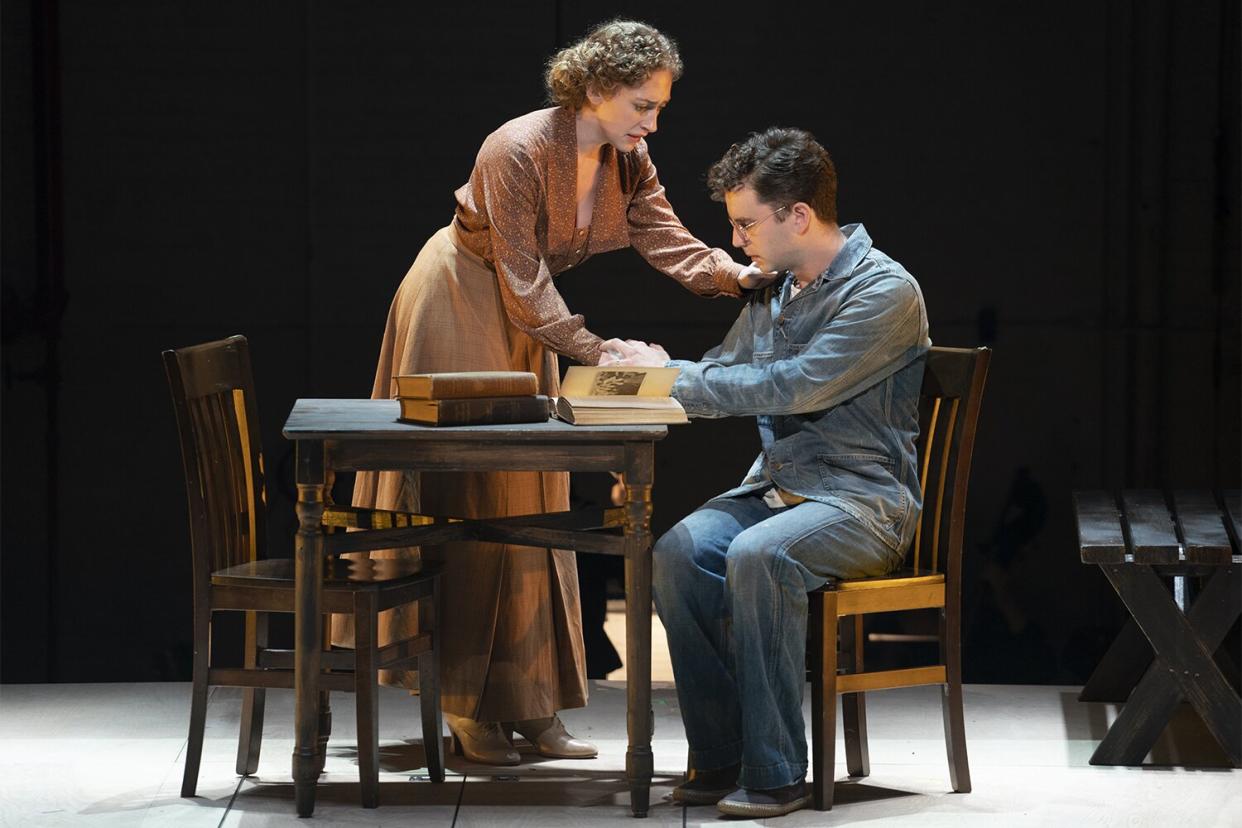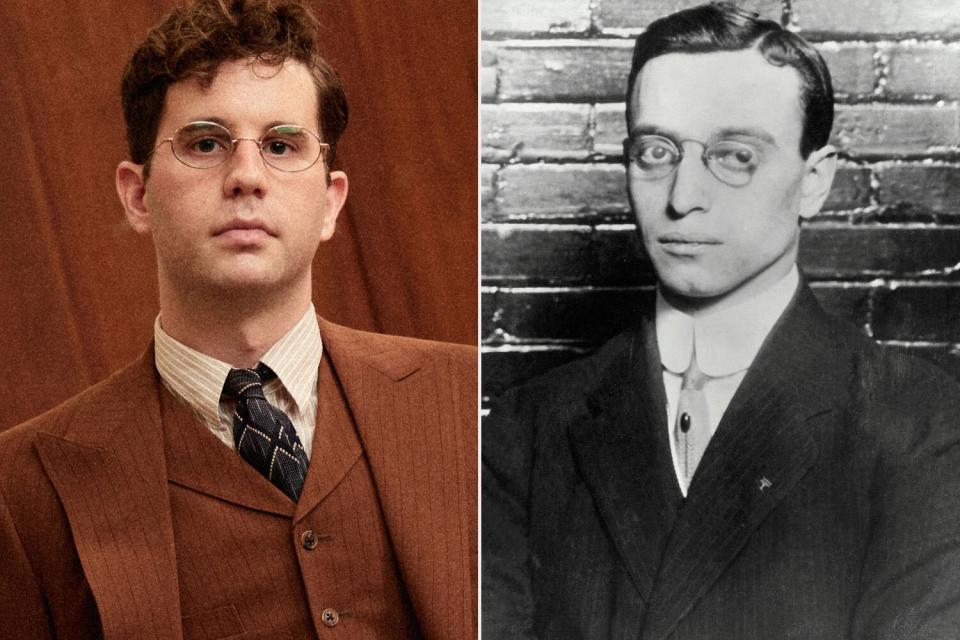The True Story Behind the Broadway Musical Parade , Starring Ben Platt

- Oops!Something went wrong.Please try again later.
- Oops!Something went wrong.Please try again later.
Joan Marcus
Ben Platt has returned to Broadway with the revival of Parade.
The musical, which originally premiered in 1998, is a dramatization of the 1913 trial of Jewish American Leo Frank, who was accused and convicted of raping and murdering a 13-year-old employee named Mary Phagan — and who received a posthumous pardon decades later.
The real-life trial in the 1910s played on rising antisemitic sentiment in the state of Georgia, and Frank was lynched by civilians after his sentence was commuted to life imprisonment.
The musical, which has a book written by Alfred Uhry and music and lyrics by Jason Robert Brown, won two Tony Awards for its relatively short run, including best book of a musical and best original score.
Platt, who is himself Jewish American, told the New York Times he was inspired to play the character after he "realized how much modern application there is for it," amid increased antisemitic rhetoric in America.
"This was a character I related to. I recognized this guy," he told the publication. "It's a lot harder to distance from than I was hoping it would be. This show is all about not only antisemitism, but the failure of the country to protect lots of marginalized groups, and we're all feeling that really intensely right now."
Following the show's first preview performance on Feb. 21, where antisemitic protesters gathered outside of the Bernard B. Jacobs Theatre in New York City, Platt addressed his followers on social media.
"For those who don't know, there were a few neo-Nazi protesters from a really disgusting group outside of the theater, bothering some of our patrons on their way in and saying antisemitic things about Leo Frank, who the show is about, and just spreading antisemitic rhetoric that led to this whole story in the first place," he said.
He then encouraged his followers to research the story and "most importantly" come see the show. "It was definitely very ugly and scary but a wonderful reminder of why we're telling this particular story and how special and powerful art and, particularly, theater can be," he said. "And just made me feel extra, extra grateful to be the one who gets to tell this particular story and to carry on this legacy of Leo."
Here's everything to know about the true story behind the musical.

Emilio Madrid; getty
Who was Leo Frank?
Leo Max Frank was born in Cuero, Texas on April 17, 1884, to parents Rudolph Frank and Rachel "Rae" Jacobs. That same year, the family moved to Brooklyn, New York, where Frank attended school. In 1902, he graduated from the Pratt Institute before attending Cornell University, where he studied mechanical engineering.
Upon his graduation, he moved to Atlanta, Georgia, where he eventually became the superintendent of the National Pencil Company. While in Atlanta, he met Lucille Selig, who came from a Jewish family of industrialists who had founded the first synagogue in Atlanta. They married in November 1910.
The two immersed themselves in the city's Jewish community and Frank was later elected president of the Atlanta chapter of the B'nai B'rith, a Jewish fraternal organization.
What was Leo Frank accused of?
On April 27, 1913, a young girl named Mary Phagan was found dead in the basement of the factory where Frank worked. Following the discovery of Phagan's body, several suspects were arrested for the crime, including the factory's night watchman, Newt Lee, who discovered Phagan, and Jim Conley, a janitor at the factory.
On April 29, Frank was arrested following suspicions about his nervous behavior during police interviews and the fact that he was the last person to admit to seeing Phagan. Lee had claimed that Frank had called the factory on April 26, the last day Phagan was seen alive, to see if everything was okay at the factory, evidence that ultimately led to his arrest, per New Georgia Encyclopedia.
What was Leo Frank's sentence?
Following a three-week trial, during which the prosecution alleged that Frank had sexual relations with several women in his office, Frank was convicted of the murder of Phagan and later sentenced to be hanged in August 1913.
Frank's team sought various state and federal appeals, but they were ultimately denied on April 19, 1915, when the Supreme Court denied the appeal by a 7–2 vote in the case Frank v. Mangum. After that, Frank's attorneys sought a commutation from Georgia governor John M. Slaton.
On June 21, 1915, Slaton released the order to commute Frank's murder conviction to life imprisonment, which sparked public outrage largely due to sensationalized media coverage of the case.
How did Leo Frank die?
Following Slaton's commutation, Frank was taken to Milledgeville State Penitentiary, though he was only there for a few months: On August 16, 1915, 25 citizens from Marietta abducted Frank from the prison and drove him back to Phagan's hometown of Marietta, where he was lynched.
What was the aftermath of Leo Frank's death?
Frank's trial, conviction and death attracted national attention to the antisemitism emerging in the south, which led to the birth of the Anti-Defamation League and the revival of the then-defunct Ku Klux Klan.
Frank was mentioned by Adolf Kraus in 1913 when he announced the creation of the Anti-Defamation League, an organization that "fights all forms of antisemitism and bias, using innovation and partnerships to drive impact," per its website.
In 1982, Charles Wittenstein, Southern counsel for the Anti-Defamation League, and Dale Schwartz, an Atlanta lawyer, attempted to obtain a posthumous pardon for Frank following a 1982 testimony from Alonzo Mann, who had been employed as an office boy at the time of the murder, and who later claimed he saw Conley carrying Phagan's body to the basement on the day of her death.
Though the pardon was denied in 1983, a second application was submitted shortly after asking the state only to admit responsibility for his death. The Georgia State Board of Pardons and Paroles approved that pardon in 1986.
"Without attempting to address the question of guilt or innocence, and in recognition of the State's failure to protect the person of Leo M. Frank and thereby preserve his opportunity for continued legal appeal of his conviction, and in recognition of the State's failure to bring his killers to justice, and as an effort to heal old wounds, the State Board of Pardons and Paroles, in compliance with its Constitutional and statutory authority, hereby grants to Leo M. Frank a Pardon," the statement read, per New Georgia Encyclopedia.
In 2019, Frank's case made headlines again when Fulton County District Attorney Paul Howard appointed an eight-person Conviction Integrity Unit to re-examine the case and determine whether it should be re-adjudicated.

